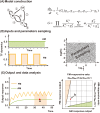Network Motifs Capable of Decoding Transcription Factor Dynamics
- PMID: 29483553
- PMCID: PMC5827039
- DOI: 10.1038/s41598-018-21945-2
Network Motifs Capable of Decoding Transcription Factor Dynamics
Abstract
Transcription factors (TFs) can encode the information of upstream signal in terms of its temporal activation dynamics. However, it remains unclear how different types of TF dynamics are decoded by downstream signalling networks. In this work, we studied all three-node transcriptional networks for their ability to distinguish two types of TF dynamics: amplitude modulation (AM), where the TF is activated with a constant amplitude, and frequency modulation (FM), where the TF activity displays an oscillatory behavior. We found two sets of network topologies: one set can differentially respond to AM TF signal but not to FM; the other set to FM signal but not to AM. Interestingly, there is little overlap between the two sets. We identified the prevalent topological features in each set and gave a mechanistic explanation as to why they can differentially respond to only one type of TF signal. We also found that some network topologies have a weak (not robust) ability to differentially respond to both AM and FM input signals by using different values of parameters for AM and FM cases. Our results provide a novel network mechanism for decoding different TF dynamics.
Conflict of interest statement
The authors declare no competing interests.
Figures







Similar articles
-
Feedback enrichment analysis for transcription factor-target genes in signaling pathways.Biosystems. 2020 Dec;198:104262. doi: 10.1016/j.biosystems.2020.104262. Epub 2020 Sep 28. Biosystems. 2020. PMID: 33002527
-
Global and local architecture of the mammalian microRNA-transcription factor regulatory network.PLoS Comput Biol. 2007 Jul;3(7):e131. doi: 10.1371/journal.pcbi.0030131. PLoS Comput Biol. 2007. PMID: 17630826 Free PMC article.
-
Inferring the transcriptional regulatory mechanism of signal-dependent gene expression via an integrative computational approach.FEBS Lett. 2020 May;594(10):1477-1496. doi: 10.1002/1873-3468.13757. Epub 2020 Feb 29. FEBS Lett. 2020. PMID: 32052437
-
Unraveling transcription regulatory networks by protein-DNA and protein-protein interaction mapping.Genome Res. 2006 Dec;16(12):1445-54. doi: 10.1101/gr.5321506. Epub 2006 Oct 19. Genome Res. 2006. PMID: 17053092 Review.
-
microRNA-Mediated Encoding and Decoding of Time-Dependent Signals in Tumorigenesis.Biomolecules. 2022 Jan 26;12(2):213. doi: 10.3390/biom12020213. Biomolecules. 2022. PMID: 35204714 Free PMC article. Review.
Cited by
-
Resonant learning in scale-free networks.PLoS Comput Biol. 2023 Feb 21;19(2):e1010894. doi: 10.1371/journal.pcbi.1010894. eCollection 2023 Feb. PLoS Comput Biol. 2023. PMID: 36809235 Free PMC article.
-
Chaotic activation of developmental signalling pathways drives idiopathic pulmonary fibrosis.Eur Respir Rev. 2020 Nov 18;29(158):190140. doi: 10.1183/16000617.0140-2019. Print 2020 Dec 31. Eur Respir Rev. 2020. PMID: 33208483 Free PMC article. Review.
-
Integrated analysis of microbe-host interactions in Crohn's disease reveals potential mechanisms of microbial proteins on host gene expression.iScience. 2022 Feb 22;25(5):103963. doi: 10.1016/j.isci.2022.103963. eCollection 2022 May 20. iScience. 2022. PMID: 35479407 Free PMC article.
-
Hierarchical and Dynamic Regulation of Defense-Responsive Specialized Metabolism by WRKY and MYB Transcription Factors.Front Plant Sci. 2020 Jan 31;10:1775. doi: 10.3389/fpls.2019.01775. eCollection 2019. Front Plant Sci. 2020. PMID: 32082343 Free PMC article.
-
Communication codes in developmental signaling pathways.Development. 2019 Jun 27;146(12):dev170977. doi: 10.1242/dev.170977. Development. 2019. PMID: 31249008 Free PMC article. Review.
References
Publication types
MeSH terms
Substances
LinkOut - more resources
Full Text Sources
Other Literature Sources
Miscellaneous

